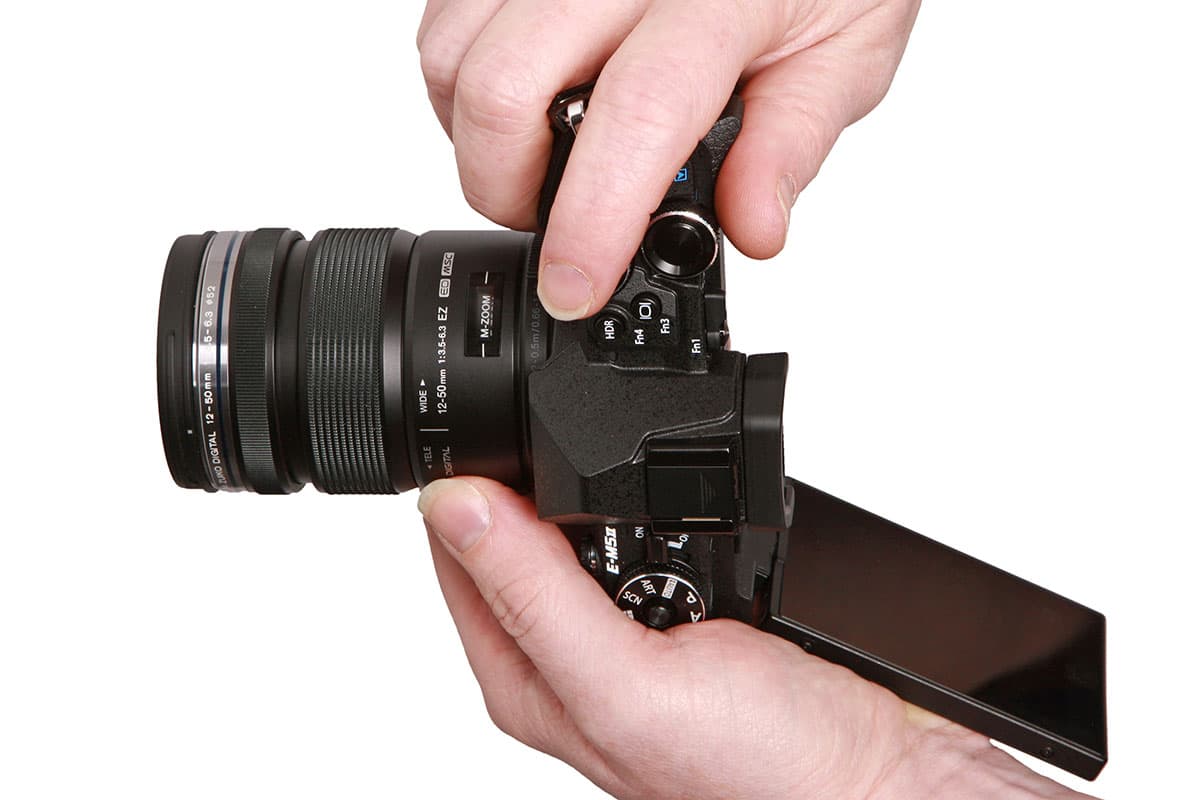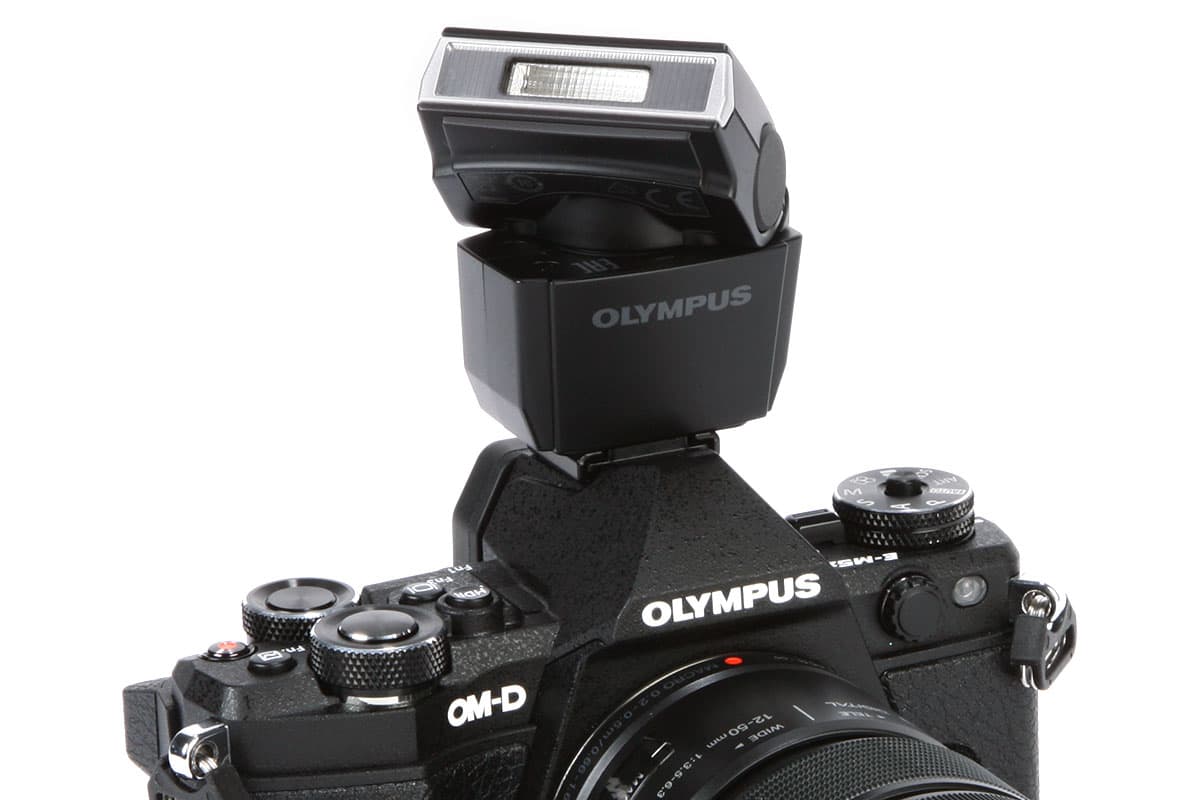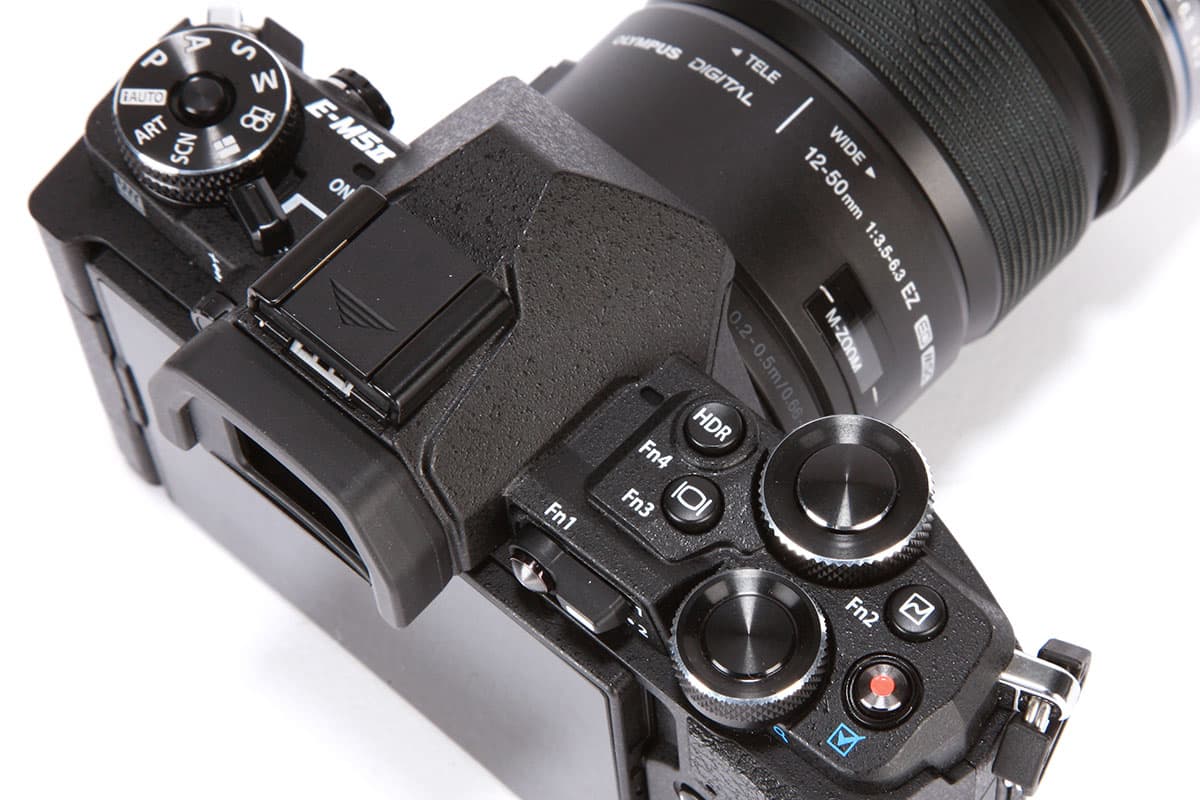We’ve had our hands on the Olympus OM-D E-M5 Mark II for a while now and have been slowly getting to know this impressively-featured, but hugely complex camera. It may have the same pixel count as the original E-M5 and look very similar, but it has an updated control layout resembling the flagship OM-D E-M1, and gains all of the little changes Olympus has made to its cameras in the intervening years. As an E-M5 owner myself, I’ve been interested in trying to pin down all of those updates and improvements, so here’s a list I put together that should be somewhere close to comprehensive. I’m not suggesting all of these will be important to any individual photographer – most probably won’t – but I find they really add up when using the E-M5 Mark II.
- 40MP high resolution mode; The camera can use its 16MP sensor to make 40MP composite images, by taking 8 shots and moving the sensor slightly between them. This only works properly with the camera on a tripod and completely static subjects, but when it does work, it’s very impressive indeed.
- Latest processor: The TruePic VII compensates for lens aberrations, most notably removing colour fringing from lateral chromatic aberration
- Updated autofocus: Users can select from 81 areas in a 9×9 grid, compared 35 areas in a 7×5 grid
- Improved image stabilisation: The Mark II now offers 5 stops of stabilisation rather than 4, includes auto panning detection, and gains the option of adding extra electronic corrections during movie recording
- Faster shutter: the mechanical shutter now goes up to 1/8000sec (vs 1/4000sec).
- Even softer shutter: The E-M5 was never exactly what you’d call loud, but the Mark II’s shutter takes quietness to an extra level. It’s incredibly soft and quiet – hold the camera at arm’s length and you can barely hear or feel it fire.
- Electronic first curtain shutter: Available as ‘0 sec anti-shock’, this uses an electronic first curtain to eliminate possible image blurring from the motion of the first curtain.
- Fully-electronic silent shutter: A completely silent fully-electronic shutter mode can be enabled, with speeds up to 1/16000 sec, but some risk of rolling shutter effects.
- Faster shooting: The E-M5 Mark II reaches 10fps with fixed focus or 5fps with autofocus, compared to 9fps and 3.5 fps.
- Much better viewfinder: The Mark II’s 2.36M dot, 0.74x magnification finder is noticeably larger and more detailed than the E-M5’s 1.44M dot, 0.57x unit (and essentially the same as the E-M1’s)

The E-M5 Mark II’s fully-articulated screen can be used as a waist-level viewfinder when shooting in portrait format
- Larger eyecup: The Mark II’s is deeper and softer, and certainly feels like it should be less prone to falling off than the E-M5’s notoriously losable one
- Adaptive viewfinder brightness: The EVF display adapts its brightness according to the ambient lighting conditions, for more comfortable viewing
- Improved screen: The Mark II has a fully-articulated 1.04M dot LCD compared to the E-M5’s 610,000 dot tilt-only OLED. It’s sharper, more flexible, and very clearly more colour-accurate
- Smarter screen switch-over: On the Mark II, the folding out the screen disables the EVF eye sensor. This means that the camera won’t switch across to the EVF when using the LCD for waist-level shooting. The flipside of this is that it’s impossible to activate the EVF when the screen is folded out.
- Additional touchscreen control: Some more shooting settings can be changed from the touchscreen, including Art Filters and Scene modes.
- ‘Selfie assist’ mode: the fully articulating screen can face forwards, so naturally this year’s ‘must have’ feature is included – a set of touchscreen controls to help you take selfies. For whatever reason Olympus isn’t promoting this as strongly for the Mark II as it did for the Pen E-PL7.
- Customisable display modes: On the Mark II, Olympus finally lets you freely choose to combine electronic levels, shadow/highlight clipping warnings, and a live histogram on the same screen. (Oddly, though, it still won’t show a manually-set ISO at the same time, although the setting chosen by the camera in Auto ISO will be displayed.) There’s also a separately-customisable movie mode display.
- Super Control Panel used by default: On the Mark II, Olympus enables its enthusiast-friendly Super Control Panel screen by default for changing shooting settings, rather than the more compact camera-like Live Control screen.
- Configurable Live View Boost settings:. Live View boost allows you to set the camera up to either preview exposure, or show a standard brightness image regardless of your settings. The two are both useful in different circumstances, and Olympus now gives more control over how you can configure them according to the exposure mode you’re using.
- Much better bundled flash: the Mark II’s can swivel and tilt for bounce flash, where the E-M5’s can only point forwards. This is actually really useful when shooting indoors with fast primes. The FL-LM3 is also weatherproof, and can act as a wireless controller for off-camera flash.

The splashproof bundled flash has a bounce head and can act as a wireless controller for off-camera units
- Revised hot shoe: adds an extra contact to provide power for the bundled flash. Panasonic has done exactly the same thing recently with the GM5 and the LX100, but sadly the two systems don’t seem to be cross compatible.
- PC sync socket: The Mark II gains a PC socket for use with studio flash
- No accessory port: The Mark II does away with the AP2 socket under the hot shoe, as it no longer has much use for it. (On the E-M5 it could accept the PenPal Bluetooth image-sharing module, the EMA-1 microphone socket adapter, the MAL-1 Macro Arm Light, and the VF-2, VF-3 and VF-4 electronic viewfinders.)
- Larger, repositioned control dials: the twin control dials are deeper, and the rear dial is now placed directly under your thumb (I find this to be a huge improvement in practical use)
- More buttons: The E-M5 always felt that it needed another button or two, and Olympus has obliged with a front-plate DOF preview button and an additional top-plate button, which by default engages HDR mode. Both these, and the repositioned EVF view mode button, are customisable to the user’s needs.
- Locking mode dial: The E-M5 Mark II gains a toggle lock on the mode dial, so users can choose to have it locked or unlocked as they see fit.
- 2×2 control scheme: Olympus has added its ‘2×2’ layout by which the dials can be temporarily re-assigned to change ISO and white balance. By default this is set via a switch on the back, but I prefer to move it onto the Fn3 (HDR) button, and use the switch to change focus mode
- Improved rear buttons: where the E-M5’s were notoriously small and spongy, the Mark II’s rear buttons are generally larger and more positive – particularly the D-pad that’s used to move the AF area.
- Repositioned power switch: The On-Off switch has been moved from the E-M5’s much-unloved position on the camera’s back to an OM-4-like spot on the top-plate. Most people who’ve used both cameras seem to prefer this.
- Customisable mode dial: User-preferred ‘Myset’ combinations of settings can be assigned to any position on the mode dial

The revised top-plate control layout includes repositioned dials, a locking mode dial, and extra buttons
- Revised hand grip: The Mark II’s slightly larger front grip and more prominent thumb ‘hook’ combine to give a more positive hold. Users with larger hands will probably still prefer to get an add-on grip.
- Repositioned tripod socket: The Mark II’s is now in-line with the lens’s optical axis, whereas the E-M5’s was offset. However the Mark II’s is now very close to the front of the baseplate.
- Built-in Wi-Fi: Allows connection to a smart device for image sharing, or remote shooting, via the free OI.Share app for Android and iOS. Alongside the usual full remote control mode with live view streamed to your phone, Olympus also includes a simple, much less power-hungry remote release option, akin to using a wireless remote.
- More Art Filters: There are always more Art Filters with each generation of Olympus camera. Compared to the E-M5, the Mark II adds Watercolor, Vintage, and Partial Colour modes, plus many additional variants of existing modes.
- ‘Picture Story’: Accessed from the mode dial, this allows several images to be combined within pre-set frames to tell a story. For many photographers I suspect this position will be the prime candidate to reassign to a custom ‘Myset’.
- Focus peaking: The Mark II gets a peaking mode that highlights high-contrast in-focus edges as a manual focusing aid. This is useful for working with non-native lenses, and refocusing during video recording
- Built-in intervalometer: up to 999 frames can be recorded, at intervals from 1 seconds to 24hrs 59mins 59secs, and with a specified delay before starting. A time-lapse movie can be assembled in-camera, too.
- Customisable self-timer: You can set a count-down time, number of frames, interval between frames, and whether the camera should refocus or not between frames.
- High Dynamic Range shooting: HDR images can be created in-camera, alternatively extended HDR bracketing can be engaged (up to 5 frames at 3EV increments)
- Live Composite mode: Joining Live Bulb and Live Time, this is a long exposure mode designed for recording light trails and light painting. It makes repeated long exposures, and adds-on to the first, base exposure any areas that are brighter in subsequent shots.

The 5-axis in-body IS system now promises 5 stops stabilisation
- Keystone Compensation: In-camera compensation for converging verticals is available, mimicking the effect of the shift lens. It’s set using the control dials, and cleverly previewed live in the viewfinder. It can also be applied in playback in-camera processing.
- Improved in-camera RAW conversion: The E-M5’s in-camera RAW converter produced JPEGs using whatever the current camera settings happened to be. The Mark II makes it trivial to tweak all of the main processing settings on a shot-by-shot basis, including colour mode, white balance, and brightness.
- Colour Creator: Alongside conventional colour modes, the Mark II gets Olympus’s Colour Creator, allowing you to adjust the image’s look using a simple graphical interface that’s naturally previewed live in the viewfinder.
- Quick Sleep mode: Puts the camera to sleep when it’s not in live view, to conserve battery life
- Choice of add-on grips: Two optional grips are available; an electronic two-piece version with additional controls and another battery, or a simple metal grip extension which includes an Arca-Swiss compatible tripod plate
- Hugely up-specced movie mode: Video recording has been transformed from the E-M5’s slightly half-hearted setup, with more framerates (24, 25, 30, 50 and 60fps), much higher bitrate (up to 77 MBPs vs 17MBPs), and the option of All-I encoding for higher quality footage.
- Timecode embedding: timecodes can be output during video recording for better synchronisation when using multiple cameras
- Microphone socket: The Mark II has a built-in stereo 3.5mm mic socket for use during video recording (in contrast the E-M5 needed the clunky EMA-1 adapter).

The Olympus OM-D E-M5 Mark II now has a microphone socket, although it interferes with the movement of the screen
- Optional headphone socket: The first part of the electronic grip includes a headphone socket, for monitoring sound during movie recording
- Touch control in movie mode: The touchscreen can be used to pull focus, change exposure settings, modify headphone volume and microphone gain settings, and operate power zoom lenses, all without jogging the camera from moving physical controls, or impinging on your soundtrack.
- Picture Mode fade during movie recording: You can set the camera to fade from one colour mode to another, or to Art Filter effects, while you’re recording video (again controlled using the touchscreen).
- Microphone volume display in video mode: always handy, you can ensure an add-on microphone is performing correctly and sound is at a reasonable level without needing headphones. Separate gain controls are available for internal and external mics.
- Uncompressed HDMI output: It’s possible to output clean video to an external recorder connected via HDMI
- Video clip recording: you can record video clips of pre-defined lengths from 1 sec to 8 sec, and compile them into a longer movie in-camera
- Vintage film effect: The camera can mimic the look of old movies, including scratches and flickering edges, which combines quite nicely with Art Filter modes for arty special effects
- No high ISO banding with Panasonic 20mm F1.7: the E-M5 gave visible banding at ISO 3200 and above with the classic Panasonic 20mm F1.7 pancake lens. The Mark II does not.
- Reduced CIPA battery life: The trade-off for all these improvements is that the Mark II is rated for 310 shots per charge rather than 360 – quite a significant drop. Buy some spares.







